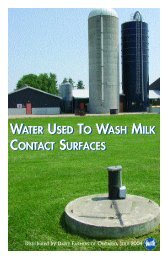Canadian Quality Milk On-Farm Food Safety Program - Centre ...
Canadian Quality Milk On-Farm Food Safety Program - Centre ...
Canadian Quality Milk On-Farm Food Safety Program - Centre ...
You also want an ePaper? Increase the reach of your titles
YUMPU automatically turns print PDFs into web optimized ePapers that Google loves.
<strong>Canadian</strong> <strong>Quality</strong> <strong>Milk</strong><br />
7.1.5 Wash System Evaluation and Maintenance<br />
<strong>Milk</strong>ing systems are washed automatically after every milking in many installations,<br />
manually in some. As with every automatic system, problems can occur. An important<br />
part of a good on-farm food safety program is the annual evaluation and maintenance of<br />
the wash system by an equipment dealer or industry professional to prevent problems<br />
from occurring. Producers who manually wash their systems do not have to have an<br />
annual wash system evaluation conducted; however, they must write their equipment<br />
cleaning procedures in their post-milking SOP and they must write their bulk tank<br />
cleaning procedures in their pre-milking SOP.<br />
The basis of the wash system evaluation is a CIP analysis (e.g. time, temperature,<br />
slugging action and chemical concentrations). The wash system evaluation should<br />
include all milk contact surfaces (e.g. milking equipment and bulk tank). A sample form<br />
is in the Workbook (Record 14b).<br />
The annual wash system evaluation must include the following parameters:<br />
Test water characteristics. The amount of detergent used<br />
depends on water characteristics. These characteristics such<br />
as hardness and iron content can vary and should be tested<br />
regularly.<br />
Ensure adequate circulation time. Cleaning time is critical<br />
for the detergents to complete the cleaning functions.<br />
Test water temperature and compare with the detergent<br />
manufacturer requirements and/or the farm’s Cleaning<br />
Some farms have very<br />
hard water, which means<br />
that the wash systems<br />
require larger volumes of<br />
detergent. Producers can<br />
install water softeners to<br />
help reduce the amount of<br />
detergent needed.<br />
and Sanitizing Chart (Record 14). Adequate water temperature is essential for an<br />
effective wash cycle.<br />
Regularly check slugging action. Water slugs are necessary to ensure proper<br />
cleaning of the milkline. A testing protocol allows the milking machine technician to<br />
adjust the air injector to obtain proper water flow conditions.<br />
Check automatic detergent dispenser for the correct amount and dispersal of<br />
chemicals regularly. Systems can be plugged and fail to dispense; therefore, they<br />
should be tested to ensure proper chemical concentration in the wash system.<br />
Include washing of all milk contact surfaces.<br />
After completing an annual wash system analysis, equipment dealers or industry<br />
professionals may identify issues with a washing system or opportunities for<br />
improvement. Some equipment dealers may check more than the CQM requirements,<br />
but producers have to correct CQM-related issues (e.g. time, temperature, slugging<br />
action and concentration).<br />
If a new wash or equipment system is installed or a major change is made in the current<br />
system, it is recommended to have another wash system analysis performed by an<br />
equipment dealer or industry professional to ensure the new or revised system washes<br />
effectively.<br />
June 2010 7—9
















